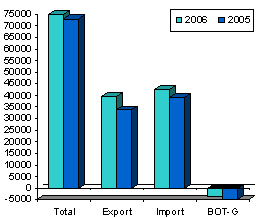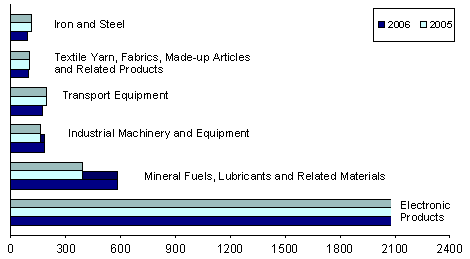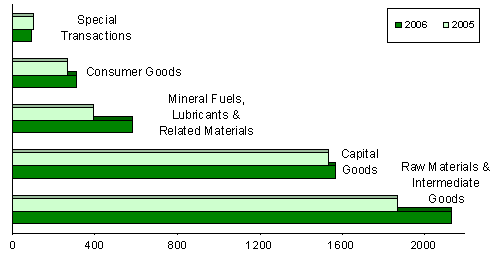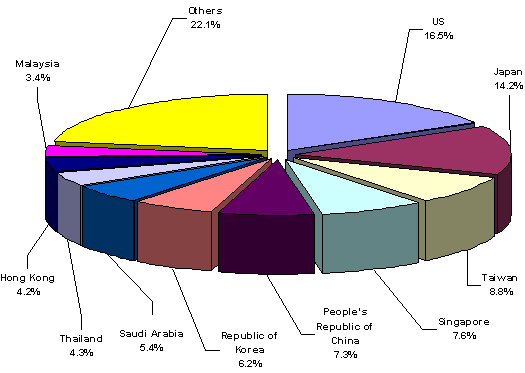| |||||||||||||||||||||||||||||||||||||||||||||||
| |||||||||||||||||||||||||||||||||||||||||||||||
r - revised
Top 10 Philippine Imports from All Countries: October 2006 | |||
Gainers | Losers | ||
| Mineral Fuels, Lubricants and Related Materials | 49.8 | Telecommunication Equipment and Electrical Machinery | -23.2 |
| Organic and Inorganic Chemicals | 16.1 | Iron and Steel | -18.7 |
| Electronic Products | 14.5 | Transport Equipment | -11.1 |
| Industrial Machinery and Equipment | 10.1 | Textile Yarn, Fabrics, Made-Up Articles and Related Products | -5.1 |
| Cereals and Cereal Preparations | 7.9 | ||
| Plastics in Primary and Non-Primary Forms | 1.3 | ||
JANUARY TO OCTOBER TOTAL TRADE STANDS AT $82.184 BILLION
Total external trade in goods for January to October in 2006 reached $82.184 billion representing a 12.5 percent increment from $73.030 billion during the same period a year earlier. Similarly, total foreign-made merchandise grew by 9.2 percent to $42.858 billion from $39.234 billion. Exports on the other hand, registered a positive rate at 16.4 percent to aggregate dollar revenue of $39.326 billion from $33.796 billion of the previous year. Balance of trade in goods (BOT-G) deficit for the Philippines reached $3.532 billion, lower compared to last year's deficit of $5.437 billion.
Figure 1A Philippine Trade Performance in January - October : 2005 and 2006
(F.O.B. Value in Million US Dollar)

Figure 1B Philippine Trade Performance in October : 2005 and 2006
(F.O.B. Value in Million US Dollar)

OCTOBER IMPORTS REGISTER 12.5 PERCENT INCREASE
Total merchandise trade for October 2006 went up by 13.9 percent to $8.876 billion from $7.794 billion during the same period last year. Dollar-inflow generated by exports reached $4.198 billion, or 15.5 percent higher than last year's $3.635 billion. On the other hand, expenditures for imported goods increased by 12.5 percent to $4.679 billion from $4.159 billion. The balance of trade in goods (BOT-G) registered a deficit at $481 million, lower from last year's deficit of $525 million.
ELECTRONIC PRODUCTS ACCOUNT FOR 52.1 PERCENT OF IMPORT BILL
Accounting for 52.1 percent of the aggregate import bill, payments for Electronic Products amounted to $2.439 billion or a 14.5 percent growth over last year's figure of $2.130 billion. Compared to the previous month's level, purchases grew by 10.3 percent from $2.211 billion. Among the major groups of electronic products, Components/Devices (Semiconductors) got the biggest share at 42.3 percent and recorded an increase of 16.1 percent to $1.981 billion from $1.706 billion during the same month in 2005.
Imports of Mineral Fuels, Lubricants and Related Materials in October ranked second with 12.5 percent share and posted the highest positive growth of 49.8 percent to $583.58 million over the previous year's level of $389.71 million. The increase was due to the high volume of importation on crude petroleum, fuel, motor spirit and other heavy petroleum oils.
Industrial Machinery and Equipment, accounting for a 3.9 percent of the total imports, ranked third as foreign bill amounted to $181.90 million or a year-on-year growth at 10.1 percent from $165.23 million last year.
Transport Equipment, contributing 3.7 percent to the total bill, was the RP's fourth top import for the month with payments placed at $173.27 million from last year's $194.94 million or a decline of 11.1 percent.
Textile Yarn, Fabrics, Made-Up Articles and Related Products, ranked fifth comprising 2.1 percent of the total imports, registered a $98.54 million worth of imports or a decrease of 5.1 percent from a year ago level of $103.80 million.
Iron and Steel recorded a share of 2.0 percent or $91.12 million worth of imports. This commodity group recorded a negative growth of 18.7 percent.
Rounding up the lists of the top imports for October 2006 were Organic and Inorganic Chemicals, $90.16 million; Plastics in Primary and Non-Primary Forms, $81.83 million; Telecommunication Equipment and Electrical Machinery, $62.19 million; and, Cereals and Cereal Preparation, $53.16 million.
Aggregate payment for the country's top ten imports for October 2006 reached $3.854 billion or 82.4 percent of the total bill.
Figure 2 Philippine Top Imports in October : 2005 and 2006
(F.O.B. Value in Million US Dollar)

RAW MATERIALS AND INTERMEDIATE GOODS ACCOUNT FOR 45.5 PERCENT OF THE TOTAL IMPORTS
Payments in October for Raw Materials and Intermediate Goods accounted for 45.5 percent as importation grew by 13.8 percent to $2.130 billion from last year's figure of $1.871 billion. Semi-Processed Raw Materials got the biggest share of 42.4 percent and valued at $1.985 billion.
Capital Goods, which comprised 33.5 percent of the total imports, went up by 2.4 percent year-on-year to $1.568 billion from $1.531 billion. The major share went to Telecommunication Equipment and Electrical Machinery with a 19.7 percent share of the total imports and billed at $920.88 million.
Mineral Fuels, Lubricants and Related Materials with a 12.5 percent share increased by 49.8 percent to $583.59 million from $389.71 million during the same period of 2005.
Purchases of Consumer Goods amounted to $305.99 million or a growth of 14.5 percent from $267.31 million in October 2005, while Special Transactions declined by 8.9 percent to $91.55 million from $100.50 million.
Figure 3 Philippine Imports by Major Type of Goods in October: 2005 and 2006

UNITED STATES CORNERS 16.5 PERCENT OF OCTOBER IMPORT BILL
United States (US) continued to be the country's biggest source of imports for October with a 16.5 percent share of the total import bill but declined by 4.5 percent to $773.31 million from $809.89 million during the same month in 2005. Exports to US amounted to $793.37 million yielding a two-way trade value of $1.567 billion and a trade surplus for RP at $20.06 million.
Japan on the other hand, came second accounting for 14.2 percent of the total import bill, up by 4.1 percent to $665.20 million from $639.05 million during the same period of 2005. Exports to Japan amounted to $669.98 million resulting to a total trade value of $1.335 billion and a trade surplus of 4.78 million.
Taiwan followed as the third biggest source of imports with an 8.8 percent share, recorded payments worth $412.91 million or a year-on-year growth of 24.6 percent. Revenue from RP's exports, on the other hand, reached $168.20 million, which generates a total trade value of $581.11 million and a $244.71 million deficit for the Philippines.
Other major sources of imports for the month of October were Singapore, $356.89 million; People's Republic of China, $341.03 million; Republic of Korea, $288.21 million; Saudi Arabia, $251.27 million; Thailand, $203.52 million; Hong Kong, $194.51 million; and Malaysia, $157.08 million.
Payments for imports from the top ten sources for the month amounted to $3.644 billion or 77.9 percent of the total.
Figure 4 Philippine Imports by Country in October: 2006

Technical Notes
1. Adjustments on electronics import statistics are based on the approved valuation methodology as per NSCB Resolution No. 8 Series of 2005 and the inclusion of transactions that passes through Automated Cargo Operating System (ACOS).
2. Analysis and Tables 1 to 5 in this Press Release is based on data using the 1993 Philippine Standard Commodity Classification (PSCC) groupings (as amended in 1999).
3. Starting with the July 2006 series of Foreign Trade Statistics (FTS), additional tables (Tables 6 and 7) using the 2004 PSCC groupings are provided.
4. The adoption of the 2004 PSCC is in compliance with NSCB Resolution No. 03, Series of 2005 entitled " Approving and Adopting the 2004 Philippine Standard Commodity Classification" by all concerned government agencies and instrumentalities.
5. In view of the adoption of the new classification system, the NSO shall issue two sets of detailed tables: 7-digit following the 1993 PSCC (as amended in 1999) and 10-digit using the 2004 PSCC simultaneously, until the December 2006 FTS. However, beginning January 2007 FTS, only the 2004 PSCC groupings will be released by NSO.
6. Detailed tables at commodity levels are available upon request from the NSO-Industry and Trade Statistics Department, 10 days after the monthly press release.
(Sgd.) CARMELITA N. ERICTA |
Source: Foreign Trade Statistics Section
Industry and Trade Statistics Department
National Statistics Office
Manila, Philippines
